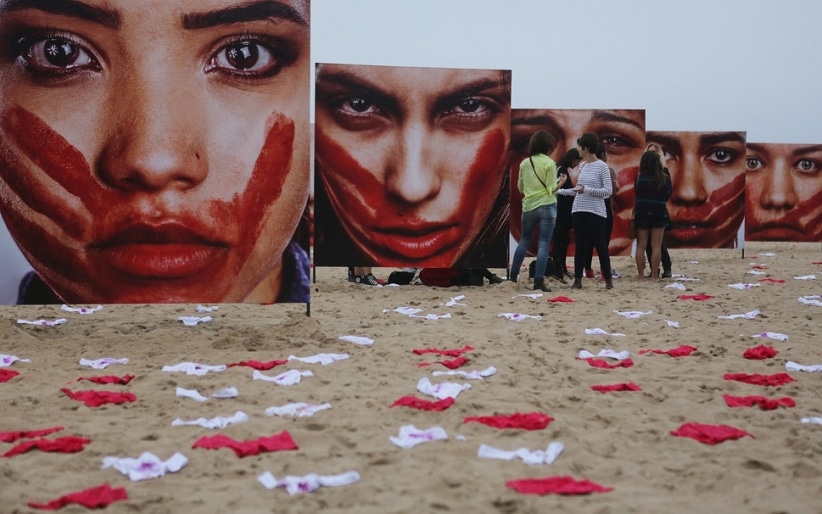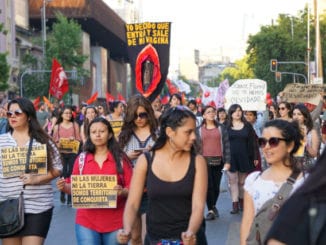
Peter Howard Wertheim & Dayse Abrantes
RIO DE JANEIRO – Brazil is improving in the depth and quality of laws that protect women from violence or death. However, activists point out that while the laws are good, the problem is more serious, it is cultural. Kids, if they are boys, are mostly given footballs and plastic guns while girls get dolls. Since childhood, this macho mentality is fostered among boys.
15 women are killed daily in Brazil

Maria da Penha was shot and crippled by her husband. Penha became nationally known for campaigning against violence against women. And the law passed to protect women from violence was named after her. Brazil ranks 5th in the world in femicides. Photo: Midia Ninja.
I have a personal example. Since my wife was very young, she learned to mountain climb and swim far into the ocean in front of Rio’s beaches such as Ipanema, with boys and was often criticized by other girls. Do you remember Tom Jobim’s famous song ‘The Girl from Ipanema’ that he also sang with Frank Sinatra?
Tall and tan and young and lovely / The girl from Ipanema goes walking / And when she passes, each one she passes goes – ah… / When she walks, she’s like a samba / That swings so cool and sways so gentle / That when she passes, each one she passes goes – ooh…
(Ooh) But I watch her so sadly / How can I tell her I love her / Yes I would give my heart gladly / But each day, when she walks to the sea / She looks straight ahead, not at me…
Tall, and tan, and young, and lovely / The girl from Ipanema goes walking / And when she passes, I smile – but she doesn’t see (doesn’t see)…
Leila Diniz (1945/1972) was a Brazilian television, movie and theatre actress, whose liberal ideas and attitudes about sex had raised the discontent of both the feminists and the Brazilian military government of the 1960s when she let herself be photographed pregnant in her bikini. Now Brazil is a bit less conservative but men keep beating or killing women.
“Maria da Penha”
In 2015, Brazil’s former President Dilma Rousseff signed a law which sets tough new penalties for the killing of women and girls. Murders linked to domestic violence will carry sentences of between 12 and 30 years.
Feminist organizations point out the new law sends a clear message to women that the state would protect them. They say 15 women are killed daily in Brazil.
In other cases – such as the killing of a pregnant woman, a woman who’s just given birth, girls under 14, or women over 60 – the new law provides for even longer jail terms.
Known as the “Maria da Penha” law, it paid tribute to Maria da Penha Maia, a woman whose ex-husband beat her for 14 years and attempted to murder her twice, leaving her paraplegic.
The “Maria da Penha” law stated that aggressors were no longer to be punished with alternative sentences. It increased the maximum sentence from one to three years. It also ordered the removal of abusers from the home and banned them from proximity to the woman or children attacked.
She is a notable figure in the movement for women’s rights in Brazil. Maria da Penha’s husband has already been released from prison after two years. Absurd!
A comprehensive report provides a snapshot of the violence that killed an average of 13 women in Brazil every day in 2013 – a 21 percent increase on the numbers a decade before, or a nine percent rise once the figure is adjusted for population increase.
While the murders of White women diminish Black women’s death toll increases
Racial killings on the rise
According to the 2015 Violence Map, Homicide of Women in Brazil by the Latin American Social Science Institute, the rising number of murders does not impact Brazilian women equally. While the number of black or mixed raced women killed grew by a horrifying 54 percent between 2003 and 2013, homicides of white women fell by 10 percent.
The trend mirrors the figures from an earlier study of all homicides between 2002 and 2012, which reported that murders within the black population increased by 29 percent, while they dropped by 25 percent for white Brazilians. Now the new report suggests that the improvement for white women is smaller than it is for white men, and the butchering of black women is even more alarming than it is for their male counterparts. In both studies the term “black” includes people of mixed race.
“There is evidence of a certain ‘radicalization’ underway in society provoking greater violence, including by the state’s security forces, against a certain profile – young, black, poor and living in periphery communities,” says Julio Waiselfisz, a sociologist and author of the Violence Map.
“Brazil is seeing more homicides among the wider black population in general, with women particularly badly affected.”
There is no clear answer to the question of why Brazil’s 49 million black women are so much more likely to be killed than their white counterparts – the groups represent 53 and 45 percent of the population respectively – or why black women are even more vulnerable to the surge of violence than black men.
Maria Sylvia de Oliveira, president of Brazil’s Geledés Institute for Black Women, told the local press that it lies primarily in their position “caught where Brazil’s two biggest pillars of oppression meet: institutionalized racism – powerful remnants of centuries of slavery that still permeate Brazil – and the dominant forces of sexism and machismo.”
De Oliveira also said that this entrenched discrimination makes opportunities to escape poverty and gain independence, and in turn fight violence, virtually impossible for many.
“Black women are at the very bottom of the social pyramid. A black woman is a non-person,” she said. “It’s the result of poverty, a lack of education, scant access to decent, stable jobs, and years of subordination whereby women are considered property.”
The Map of Violence report comes at a time when the Brazilian authorities claim to be tackling the issue, and amid signs of burgeoning discussion of violence against women among the wider public, notably the inclusion of an essay question on Brazil’s “persistence of domestic violence” in a national university entrance exam last year sat by 7.7 million students.
Peter Howard Wertheim is an international energy journalist, based in Rio de Janeiro, Brazil. He can be reached at: peterhw@frionline.com.br



630699 140438You produced some decent points there. I looked online for your dilemma and located many people will go together with with the internet site. 106618
Could I include this content in my dataset with your permission? This data collection is part of my personal hobby as a data scientist, and I want to emphasize that I’ll continue to cite the source in every case. Here my campus page at Kampus Terbaik Thanks! ID : CMT-GT1UQ891X3J33EX509
644507 50583I take fantastic pleasure in reading articles with quality content material. This article is 1 such writing that I can appreciate. Keep up the good function. 229255
502202 657907Wow ~ Very good stuff ~ Come and check out MY ?? 598294
422771 832374Im glad to become a visitor in this pure internet site, regards for this rare information! 878156
859964 173257I got what you intend, saved to bookmarks , quite decent web site . 427111
316894 97351Aw, it was an very excellent post. In thought I would like to set up writing related to this in addition – taking time and actual effort to create a very good article but exactly what do I say I procrastinate alot and also no indicates manage to go done. 338554
591398 216755We offer the most effective practical and most applicable solutions. All our Sydney plumbers are experienced and qualified and are able to rapidly assess your issue and locate the very best remedy. 706185